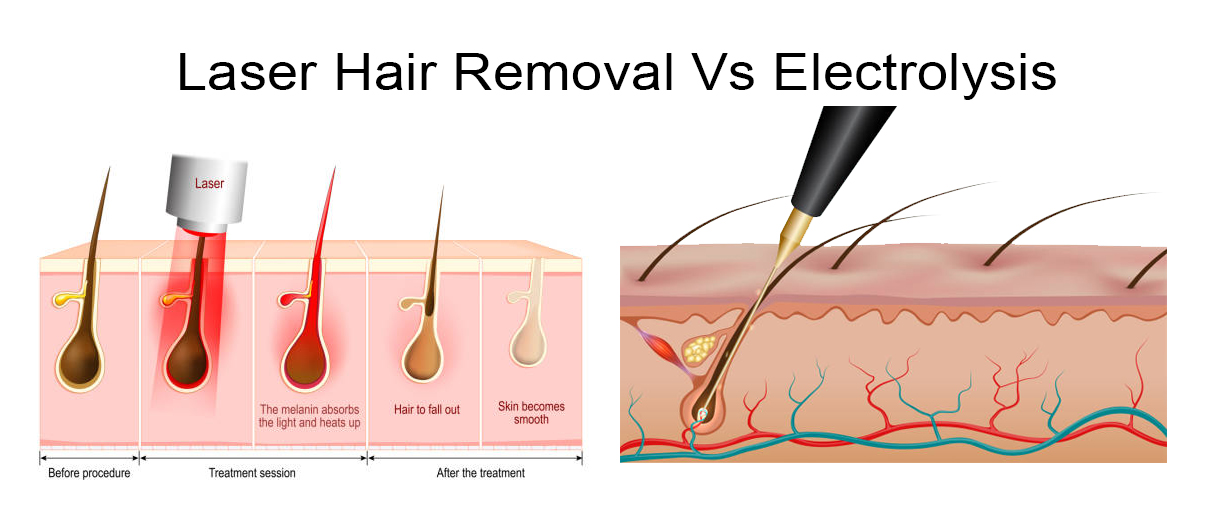Table of Contents
Introduction: The Basics of Electrolysis Hair Removal
Electrolysis is a tried-and-true method of permanent hair removal that’s been in practice for over a century. Unlike other hair removal techniques targeting hair pigment, electrolysis hair removal targets the hair follicle. Using a fine probe to penetrate the hair follicle and deliver an electric charge successfully inhibits the follicle from regenerating hair.
Why Traditional Hair Removal Methods Fall Short for Certain Hair Colours
Classical hair removal approaches, including waxing, shaving, and standard laser treatments, frequently utilize the difference in pigment between the hair and skin to achieve effective removal. These methods can be ineffective or short-lived for individuals with blonde, white, gray, or red hair. The lack of dark pigment in these hair types means that lasers can’t target them effectively, and shaving or waxing only offers temporary relief.
Challenges in Removing Light-Coloured and Red Hair
Why Typical Laser Treatments Aren't Always Effective
Laser hair removal hones in on the hair’s melanin, causing harm to the follicle. However, the laser doesn’t have enough target pigment to be effective for hair types that lack significant melanin, like blonde, gray, or white hair. Even red hair, which contains a type of melanin called pheomelanin, is often only sometimes effectively treated by many lasers.

The Unique Characteristics of Blonde, White, Gray, and Red Hair
Each of these hair colours has its distinct characteristics. Blonde hair might have minimal melanin, while white and gray hair lacks melanin altogether. Gray hair is a mix of pigmented and unpigmented strands, and its coarse texture can also pose challenges for removal. Red hair contains pheomelanin, a pigment that doesn’t absorb laser energy as efficiently as the eumelanin found in brown or black hair.
Deep Dive: Electrolysis Hair Removal Explained
How Electrolysis Works
The magic of electrolysis lies in its targeted approach. A professional electrologist inserts a tiny probe into the hair follicle. Once it’s in place, an electric current is passed down the probe, destroying the follicle’s ability to produce hair. Since it directly targets the follicle rather than the pigment in the hair, electrolysis is effective for all hair types and colours.
The Advantages of Electrolysis Hair Removal
Electrolysis boasts numerous benefits over other hair removal methods:
- Universality: It’s suitable for all skin and hair types, making it ideal for those with light-coloured or red hair with limited options with traditional laser treatments.
- Permanence: Electrolysis offers a permanent solution. Once a hair follicle is destroyed, it won’t produce hair again.
- Safety: When performed by trained professionals, the risk of scars, burns, or other complications is minimal.

Suitability of Electrolysis for Different Hair Colours
Given its mechanism of action, electrolysis hair removal emerges as the champion for hair removal in individuals with blonde, white, gray, or red hair. While laser treatments might offer hope for some, the inconsistency in results, especially for these hair colours, can be frustrating. Electrolysis fills this gap, offering a consistent, reliable, and permanent solution, ensuring that people of all hair colours can enjoy smooth, hair-free skin.
Electrolysis Hair Removal for Blonde Hair
Blonde hair, ranging from platinum to dirty blonde, poses a challenge for most hair removal methods. With reduced melanin, lasers often fail to detect and treat these lighter strands adequately. Enter electrolysis – a method that doesn’t rely on melanin detection. For those with blonde hair, electrolysis is a beacon of hope. It ensures that the hair follicle is targeted, irrespective of its colour. Therefore, those radiant blonde strands that once seemed so resistant to removal can now be effectively and permanently addressed.


Electrolysis Hair Removal for White and Gray Hair
The journey of hair turning gray or white results from the gradual loss of melanin. Unlike their pigmented counterparts, these hair types lack melanin altogether, making them immune to traditional laser treatments. Electrolysis, with its unique approach of bypassing the need for pigment detection, is perfectly suited for white and gray hair. Each hair follicle, devoid of colour, is meticulously treated, ensuring a thorough removal process that leaves the skin smooth and hair-free.
Electrolysis Hair Removal for Red Hair
Red hair, with its fiery and vibrant strands, contains a type of melanin different from that in darker hairs – pheomelanin. This unique pigment type doesn’t absorb laser energy as efficiently, rendering many laser treatments ineffective. Electrolysis hair removal shines as the ideal solution for redheads. By targeting the follicle directly and sidestepping the need to detect pigment, every strand of red hair can be tackled with precision.

The Procedure: What to Expect
Initial Consultation
Before diving into the world of electrolysis, an initial consultation is crucial. This meeting allows the electrologist to understand your hair, skin, and any underlying medical conditions. You’ll discuss your desired outcomes potential risks, and get a roadmap for the upcoming treatments. This is also an excellent opportunity to address any questions or concerns.
During the Treatment
During an electrolysis hair removal session, you’ll be positioned comfortably while the practitioner cleans the target area. A fine probe will then be inserted into each hair follicle, after which a brief electric current is applied, targeting and destroying the follicle’s growth center. The process can feel like a slight pinch or a warm sensation, but most clients find it tolerable. Each session’s duration depends on the treated area, with larger areas requiring more time.
Post-Treatment Care
After your session, some redness and swelling are normal. Keeping the area clean is crucial, so avoid touching or scratching. The electrologist may recommend specific creams or aloe gels to alleviate any discomfort. Avoiding direct sunlight on the treated area is essential, ensuring minimal hyperpigmentation or irritation risk.
Benefits of Electrolysis for Light-Coloured and Red Hair
Precision and Effectiveness
Electrolysis stands out for its unparalleled precision. Treating each follicle individually ensures comprehensive and effective hair removal, especially for hair colours that other treatments can’t effectively handle.
Permanent Hair Removal
One of the most significant advantages of electrolysis is its permanence. Unlike other methods that may require ongoing maintenance, electrolysis provides a lasting solution. Once treated, a follicle won’t regenerate, leading to permanent hair reduction.
Safety and Minimized Risks
Electrolysis, when performed by trained professionals, boasts an excellent safety profile. The method doesn’t rely on external radiation or chemicals. And since it’s been in use for over a century, its safety and effectiveness have stood the test of time.
Potential Side Effects and How to Mitigate Them
Electrolysis hair removal is generally well-tolerated. However, like any procedure, it can come with potential side effects. Some clients might experience redness, swelling, or minor skin irritation post-treatment. Rarely, there may be instances of tiny scars or skin discoloration.
To mitigate these effects:
- Always seek treatment from a trained and certified electrologist.
- Follow post-treatment care guidelines meticulously.
- Avoid direct sunlight or use sunscreen to prevent hyperpigmentation.
- Keep the treated area clean and free from potential irritants.


Common Side Effects of Electrolysis
Electrolysis hair removal, though generally safe, can cause certain side effects. The most common include:
- Redness and Swelling: These are typical reactions immediately following the procedure. The skin around each treated hair follicle might show redness and minor swelling.
- Pain or Discomfort: Some people might feel pinching during the procedure. The level of discomfort varies from person to person and can depend on the treatment area.
- Skin Discoloration: Temporary changes in the colour of treated skin can occur, especially in people with darker skin tones.
- Infections: Though rare, if post-treatment care instructions aren’t followed, there’s a possibility of infection in treated areas.
- Scarring: In rare instances, especially if the skin is prone to keloid formation, electrolysis can cause scars.
Tips for Reducing Potential Side Effects
To minimize potential side effects, consider the following tips:
- Choose a Qualified Electrologist: Always ensure your electrologist is licensed and experienced. The practitioner’s skill can greatly affect results and side effects.
- Follow Aftercare Instructions: This might include avoiding certain products, keeping the area clean, or staying out of the sun.
- Discuss Pain Management: If you’re concerned about discomfort, discuss pain management options with your electrologist. Topical anesthetics can sometimes be applied.
- Stay Hydrated: Drinking water can help the skin heal faster and reduce swelling and redness.
Comparing Electrolysis with Other Hair Removal Methods
Electrolysis vs Laser Hair Removal
While both electrolysis hair removal and laser hair removal aim to reduce unwanted hair permanently, they have distinct differences:
- Method: While electrolysis uses electric currents to destroy hair follicles, laser hair removal uses light energy.
- Effectiveness on Hair Types: Electrolysis can treat all hair colours and types, while laser hair removal is typically more effective on darker hair.
- Duration of Treatment: Electrolysis might require more sessions since it targets individual hair follicles, whereas lasers can target multiple follicles simultaneously.
- Cost: Laser treatments can sometimes be more expensive upfront, but the need for fewer sessions can offset the costs.


Electrolysis vs Shaving and Waxing
- Permanency: Electrolysis hair removal provides a permanent solution, whereas shaving and waxing are temporary.
- Maintenance: Shaving or waxing requires ongoing, often frequent, maintenance, while electrolysis reduces the need for future treatments.
- Skin Health: Waxing can lead to ingrown hairs and irritation, and shaving might result in nicks or cuts. Electrolysis, when done correctly, poses fewer risks.
Testimonials and Real-world Experiences
Success Stories: Before and After
Several individuals have experienced transformative results with electrolysis. Their ‘before’ photos often showcase thick, coarse, or conspicuous hair, while ‘after’ images reveal smooth, hair-free, and clearer skin. These testimonials underscore the power and effectiveness of electrolysis.
Feedback from Individuals with Blonde, White, Gray, and Red Hair
The challenges of lighter hair colours or unique shades like red are frequently discussed. Testimonials from such individuals often emphasize their struggles with other hair removal methods and their success with electrolysis. Their stories can be a beacon of hope for those skeptical about the procedure.
Conclusion: Making the Right Choice for Your Hair Type
Weighing the Pros and Cons
Electrolysis, like any procedure, comes with both advantages and drawbacks. While it offers permanency and suitability for all hair types, the need for multiple sessions and potential side effects might deter some.
Seeking Professional Advice for Best Results
Before opting for any hair removal method, it’s essential to consult professionals. They can offer customized guidance considering individual hair textures, skin reactions, and expected results. For many, especially those with blonde, white, gray, or red hair, electrolysis is optimal, providing lasting results and renewed confidence.
Book Your Free Consultation Today Or Call 647-493-8408
Q&A
What are some common side effects of electrolysis?
Common side effects include redness, swelling, pain or discomfort, skin discoloration, potential infections, and, in rare cases, scarring.
How can one minimize the potential side effects of electrolysis?
One can minimize potential side effects by choosing a qualified electrologist, following aftercare instructions closely, discussing pain management options, and staying hydrated.
How does electrolysis differ from laser hair removal?
Electrolysis uses electric currents to destroy individual hair follicles, while laser hair removal utilizes light energy to target multiple follicles. While electrolysis works well for every hair shade and kind, lasers usually show better results with darker hair.
Why might someone choose electrolysis over shaving or waxing?
Electrolysis provides a permanent solution, reducing the need for future treatments. In contrast, shaving and waxing are temporary methods that require regular maintenance and may lead to issues like ingrown hairs, irritation, nicks, or cuts.
Are there real-world testimonials showcasing the effectiveness of electrolysis?
Many individuals have provided before and after photos and stories highlighting the transformative results they’ve achieved with electrolysis.
How effective is electrolysis for individuals with blonde, white, gray, or red hair?
Electrolysis is particularly effective for these hair colours, with many individuals emphasizing their success with this method after facing challenges with other hair removal techniques.
How does electrolysis stand out in the context of permanency and hair removal?
Electrolysis offers a permanent solution, targeting and destroying individual hair follicles, ensuring they don’t regenerate.
How can a person ensure they get the best results from electrolysis?
It’s crucial to seek professional advice before opting for the procedure. This ensures tailored advice based on individual hair types, skin sensitivities, and desired outcomes.
Can electrolysis help with ingrown hairs?
Electrolysis can target and remove stubborn ingrown hairs due to its cauterizing effect.
Is electrolysis suitable for all skin types?
Electrolysis is suitable for every skin type, rendering it a flexible choice for numerous people.

